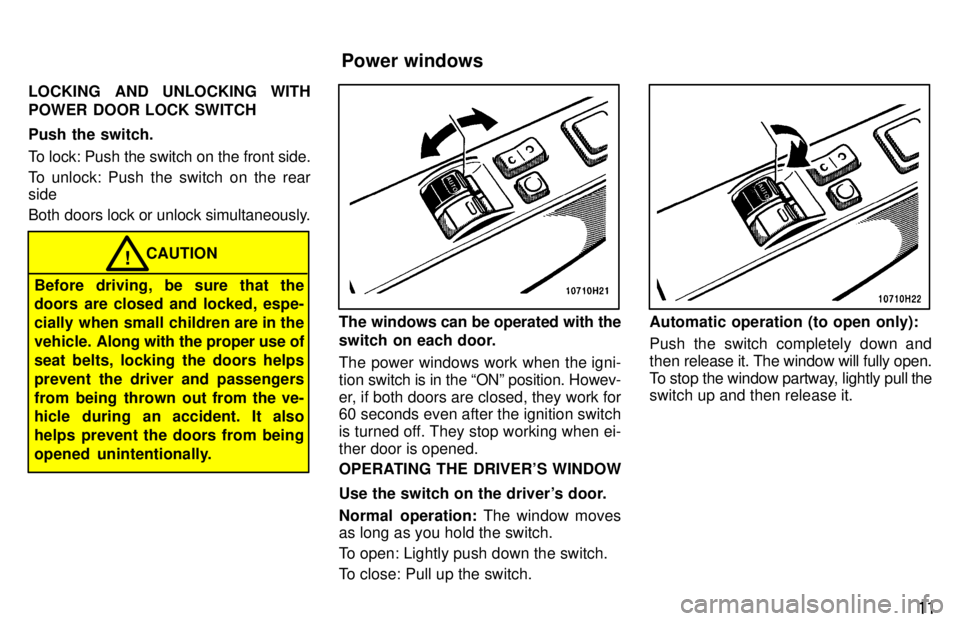Page 4 of 221
3
1. Headlight and turn signal switch
2. Wiper and washer switches
3. Driving pattern selector button
4. Emergency flasher switch
5. Clock
6. Cup holder
7. Air conditioning controls
8. Car audio
9. Ashtray
10. Cigarette lighter 11. Parking brake lever
12. Ignition switch
13. Cruise control switch
14. Hook lock release lever
15. Rear differential lock button
16. Instrument panel light control knob
17. Clutch start cancel switch
Page 10 of 221
10
LOCKING AND UNLOCKING WITH KEY
Insert the key into the keyhole and turn
it.
To lock: Turn the key forward.
To unlock: Turn the key backward.
Vehicles with power door lock sys-
temÐBoth doors lock and unlock simulta-
neously with either door. In the driver's
door l ock, turning the key once will unlock
the driver's door and twice in succession
will unlock the driver's door and passen-
ger's door simultaneously.LOCKING AND UNLOCKING WITH IN-
SIDE LOCK BUTTON Move the lock button.
To lock: Push the button downward.
To unlock: Pull the button upward.
Closing the door with the lock button
pushed in w ill also lock the door. Be care-
ful not to lock your keys in the vehicle.
Vehicles with power door lock systemÐ
The door cannot be locked if you leave thekey in the ignition switch.Driver's side
Passenger 's side
Side doors
Page 11 of 221

11
LOCKING AND UNLOCKING WITH
POWER DOOR LOCK SWITCH Push the switch.
To lock: Push the switch on the front side.
To unlock: Push the switch on the rear side
Both doors lock or unlock simultaneously.
CAUTION!
Before driving, be sure that the
doors are closed and locked, espe-
cially when small children are in the
vehicle. A long with the proper use of
seat belts, locking the doors helps
prevent the driver and passengers
from being thrown out from the ve-
hicle during an accident. It also
helps prevent the doors from being
opened unintentionally.
The windows can be operated with the
switch on each door.
The power windows work when the igni- tion switch is in the ONº position. Howev-
er, if both doors are closed, they work for 60 seconds even after the ignition switch
is turned off. They stop working when ei-ther door is opened.
OPERATING THE DRIVER'S WINDOW
Use the switch on the driver's door.
Normal operation: The window moves
as long as you hold the switch.
To open: Lightly push down the switch.
To close: Pull up the switch.Automatic operation (to open only):
Push the switch completely down and
then rel ease it. The window will fully open.
To stop the window partway, lightly pull the
switch up and then release it.
Power windows
Page 31 of 221

31
This indicator comes on when the
ignition key is turned to the ACCº or
ONº position. It goes off after about 6
seconds. This means the SRS airbag
is operating properly.
The SRS airbag warning light system
monitors the airbag sensor assembly, in-
flators, warning light, interconnecting wir-
ing and power sourcesThe SRS airbag system is designed to
activate in response to a severe frontal
impact within the shaded area be-
tween the arrows in the illustration.
The SRS airbags will deploy if the severity
of the impact is above the designed
threshold level, comparable to an approxi-
mate 20 km/h (14 mph) collision when im-
pacting straight into a fixed barrier that
does not move or deform.
If the severity of the impact is below the
above threshold level, the SRS airbags
may not deploy. However, this threshold velocity will be
considerably higher if the vehicle strikes
an object, such as a parked vehicle or sign
pole, which can move or deform on im-
pact, or if it is
involved in an underride col-
lision (e.g. a collision in which the noise of
the vehicle underridesº, or goes under, the bed of a truck).
For the safety of all occupants, be sure to
always wear your seat belts.
Page 34 of 221

34
This SRS airbag system has a service re-
minder indicator to inform the driver of op-
erating problems. If either of the following
conditions occurs, this indicates a mal-
function of the airbags. Contact your To-
yota dealer as soon as possible to service
the vehicle. � The light does not come on when the
ignition key is turned to the ACCº or
ONº position, or remains on.
� The light comes on while driving.In the following cases, contact your Toyo-
ta dealer as soon as possible: �The SRS airbag has been inflated.
� The front part of the vehicle (shaded in the illustration) was involved in an ac-
cident not of the extent to cause the
SRS airbags to inflate
� The pad section of the steering wheel
(shaded in the illustration)is scrat-
ched, cracked, or otherwise damaged. Toyota strongly urges the use of child
restraint systems for children small
enough to use them.
The laws of all fifty states in the U.S.A.
and Canada now require the use of a child
restraint system.
Your vehicle conforms to SAEJ1819.
If a child is too large for a child restraint
system,
the child should sit in the rear seat
and must be restrained using the vehicle's
seat belt. See Seat beltsº for details.CAUTION!
� For effective protection in automo-
bile accidents and sudden stops,
children must be properly re-
strained using a seat belt or child
restraint system depending on the
age and size of the child. Holding
a child in your arms is not a substi-
tute for a child restraint system. In
an accident, the child can be
crushed against the windshield, or
between you and the vehicle's in-
terior.
Child restraintÐ ÐChild restraint precautions
Page 35 of 221

34
This SRS airbag system has a service re-
minder indicator to inform the driver of op-
erating problems. If either of the following
conditions occurs, this indicates a mal-
function of the airbags. Contact your To-
yota dealer as soon as possible to service
the vehicle. � The light does not come on when the
ignition key is turned to the ACCº or
ONº position, or remains on.
� The light comes on while driving.In the following cases, contact your Toyo-
ta dealer as soon as possible: �The SRS airbag has been inflated.
� The front part of the vehicle (shaded in the illustration) was involved in an ac-
cident not of the extent to cause the
SRS airbags to inflate
� The pad section of the steering wheel
(shaded in the illustration)is scrat-
ched, cracked, or otherwise damaged. Toyota strongly urges the use of child
restraint systems for children small
enough to use them.
The laws of all fifty states in the U.S.A.
and Canada now require the use of a child
restraint system.
Your vehicle conforms to SAEJ1819.
If a child is too large for a child restraint
system,
the child should sit in the rear seat
and must be restrained using the vehicle's
seat belt. See Seat beltsº for details.CAUTION!
� For effective protection in automo-
bile accidents and sudden stops,
children must be properly re-
strained using a seat belt or child
restraint system depending on the
age and size of the child. Holding
a child in your arms is not a substi-
tute for a child restraint system. In
an accident, the child can be
crushed against the windshield, or
between you and the vehicle's in-
terior.
Child restraintÐ ÐChild restraint precautions
Page 52 of 221

Part 1Headlights and turn signals
51
OPERATION OF INSTRUMENTS ANDCONTROLSÐ
Chapter 1-4
Lights and Wipers �
Headlights and turn signals
�Emergency flashers
�Instrument panel light control
�Interior light
�Personal light
�Ignition switch light
�Windshield wipers and washer
HEADLIGHTS
To turn on the following lights: Twist
the headlight/turn signal lever knob. Position 1ÐParking, tail, license plate,
side marker and instrument panel lights Position 2ÐHeadlights and all of the above If you turn the ignition switch to the
LOCKº position with the headlights lefton, a a buzzer reminds you to turn the
lights off
when you open the driver's door.
NOTICE
To prevent the battery from being discharged, do not leave the lights
on for a long period when theengine is not running.
Daytime running light system (Canada only)
The headlights turn on when the parking brake is released with the engine started,
even with the light switch in the OFFº position. They will not go off until the igni-
tion switch is turned off.
To turn on the other exterior lights and in-
strument panel lights, twist the knob to the
position 1.
Under the daytime running light system,
the headlights turn on at reduced intensi-
ty. Twist the knob to the position 2 to turn
to full intensity for driving at night.
Page 55 of 221
54To turn on the interior light, slide the switch.
The interior light has the following posi- tion:
ONºÐKeeps the light on all the time.
OFFºÐTurns the light off.
DOORºÐTurns the light on when either
door is opened. The light goes off when both doors are closed.
The personal lights operate separately
with each other switch.
To turn on the light, push the switch on
your side. To turn the light off, push the
switch once again.
The center switch has the following posi- tions:
Position 1ÐTurns both lights on when ei-
ther
door is opened. The lights go off when
both doors are closed.
Position 2ÐThe lights are off unless you operate either outerswitch.For easy access to the ignition switch,
the ignition switch light comes on
when the driver's door is opened.
The light remains on for a some time after
the driver's door is closed.
Ignition switch light
Personal light